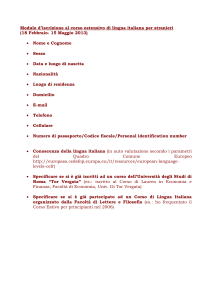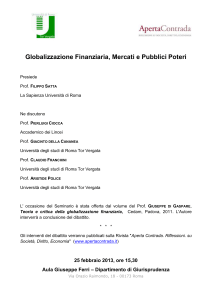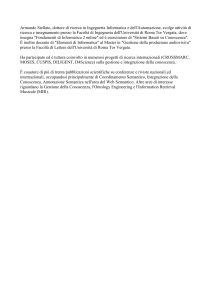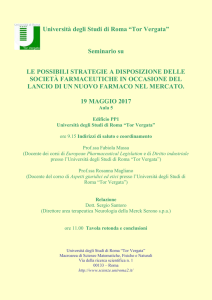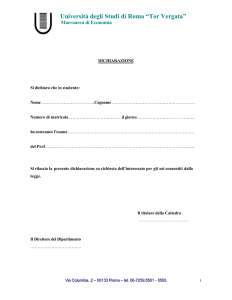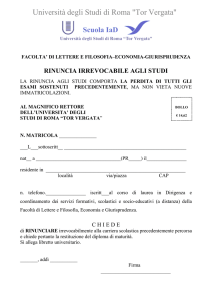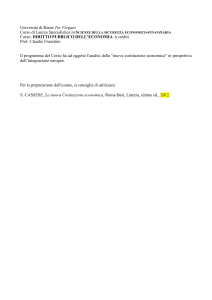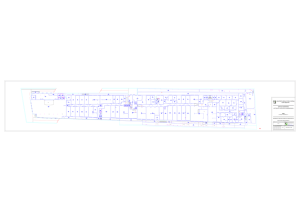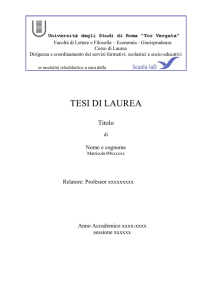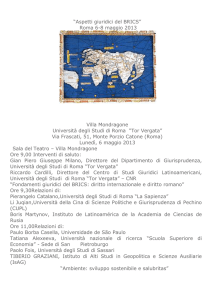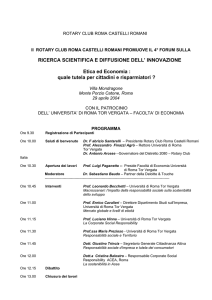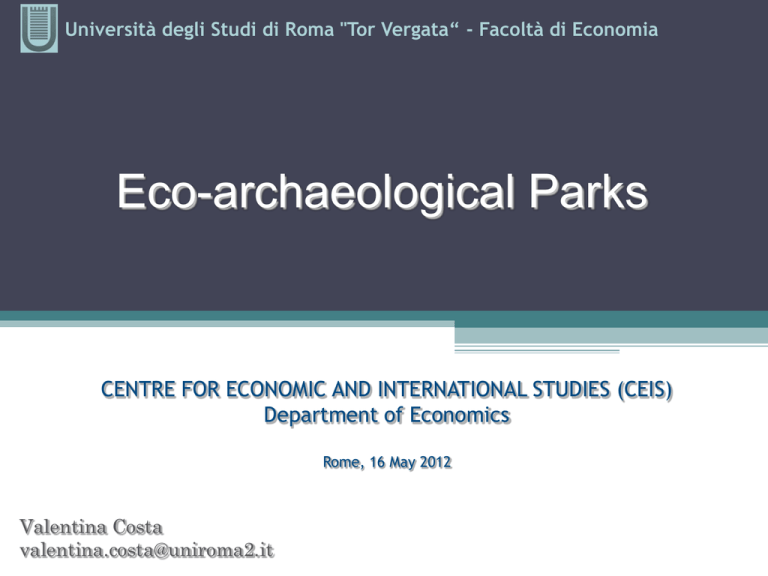
Università degli Studi di Roma "Tor Vergata“ - Facoltà di Economia
Eco-archaeological Parks
CENTRE FOR ECONOMIC AND INTERNATIONAL STUDIES (CEIS)
Department of Economics
Rome, 16 May 2012
Valentina Costa
[email protected]
Università degli Studi di Roma Tor Vergata
Facoltà di Economia – Dipartimento SEFeMEQ
PART I
Management of eco-archaeological parks
Definition of Eco-archaeological Parks
Integrated Approach
Socio-economic and Environmental Sustainability
Multifunctional Model VS Minimalist Model
Università degli Studi di Roma Tor Vergata
Facoltà di Economia – Dipartimento SEFeMEQ
How to define eco-archaeological parks?
Imagine the meeting of Disney, Indiana Jones e National Geographic …
Università degli Studi di Roma Tor Vergata
Facoltà di Economia – Dipartimento SEFeMEQ
Features of Eco-archaeological Parks
The eco-archaeological park is a work of art through which the
suspension of disbelief occurs (Scandizzo, La realtà digitale e i
giovani), involving simultaneously:
Archaeology
Adventure
Nature
Role-playing
game
Università degli Studi di Roma Tor Vergata
Facoltà di Economia – Dipartimento SEFeMEQ
Why do we need eco-archaeological parks?
Archaeological and Environmental Reasons
Protecting and developing management strategies of archaeological
sites and natural parks by applying either archeology of the
senses or archeology of experience
Economic reasons
Attracting foreign capital, investment and tourists
Political reasons
Meeting the demands of ethnic identities - e.g. Mayan communities in
Mexico or Bedouins in Egypt
Università degli Studi di Roma Tor Vergata
Facoltà di Economia – Dipartimento SEFeMEQ
Definition of cultural heritage
Cultural heritage includes tangible culture (e.g. buildings, monuments,
landscapes, books, works of art, and artifacts), intangible culture (e.g.
folklore, traditions, language, and knowledge), and natural heritage
(including culturally significant landscapes, and biodiversity)
Features of cultural and natural heritage (European Commission,
2002):
• unique and irreplaceable
• public resource
• high level of damage risks
• use and non-use estimation of prices
Università degli Studi di Roma Tor Vergata
Facoltà di Economia – Dipartimento SEFeMEQ
Eco-archaeological parks as cultural indutries
Integrated Approach
The Integrated Approach refers to an interconnected rehabilitation of
both cultural and environmental resources, contributing to re-build
the unitary identity of the sites by adopting an ecological and
contingent perspective in line with local authenticity.
Cultural and natural heritage management needs to fit three interrelated dimensions: environmental, social and economic sustainability
(Adams, 2006) that “meet the needs of the present without
compromising the ability of future generations to meet their own
needs” (World Commission on Environment and Development,1987).
Università degli Studi di Roma Tor Vergata
Facoltà di Economia – Dipartimento SEFeMEQ
Socio-economic sustainability
The preservation and valorisation of historic heritage and local
cultural resources have been particularly adopted as a strategy of local
development and poverty reduction since the 90’s. Local cultural
resources and heritage are considered as assets that may generate,
directly or indirectly, positive economic effects:
• Direct effects (Economic ones)
Job creation and promotion of activities in the cultural sector which
improves the active participation of locals
• Indirect effects (Political, spiritual, and social values)
Involving the community in tourism, documentation and conservation
activities strengthens, in fact, the self-identity and people become not
only the site managers, but the main responsible for the site survival.
Università degli Studi di Roma Tor Vergata
Facoltà di Economia – Dipartimento SEFeMEQ
Environmental sustainability
Natural elements of the landscape can acquire meaning for a
particular group, and in that case they become cultural heritage.
These may include landforms, flora, fauna and minerals and the
unclear landscape is highly valued by locals because it provides a link
to the traditional landscape. Native vegetation is valued for many
traditional uses including health and nutritional benefits, fibres,
implements raw materials for artwork.
Safeguarding the landscape, therefore, means protecting natural
resources as well as local traditions and cultures. Considering the
importance of natural resources as cultural heritage and, moreover,
their core role in developing eco-archaeological parks, the
Environmental Development dimension aims at measuring the
environmental impact of the activities promoted by the parks.
Università degli Studi di Roma Tor Vergata
Facoltà di Economia – Dipartimento SEFeMEQ
Economic evaluation of alternatives
The Economic Model revolves around the dual concept of use and nonuse value as key components of the value creation process spurred by
conservation, and cultural production within a community setting and a
broader territory. Furthermore, it should incorporates uncertainty as
one of the basic variables at the roots of the threats and opportunities
that heritage poses in a real setting.
The methodology of planning is based on a sequence of two phases
(Minimalist and Multifunctional), for each of those efficient budget
planning are presented, including Net Present Value (NPT) and real
options. The economic values created by the implementation of the
program derives not only from the benefit flow for the beneficiaries, but
also from the options that the sequence gradually creates and exploits
by adopting an “act, learn and then act” strategy through the transition
from the Minimalist to the long term scenario
Università degli Studi di Roma Tor Vergata
Facoltà di Economia – Dipartimento SEFeMEQ
Scenarios
Building Scenarios
Scenarios are not written to be predictive but to encourage conceptual
design and efficient budget planning. Scenarios need to be
contextualised at national level first, and then at local one. However,
none of the scenarios is a strategy likely to become reality in all its
elements, and indeed some aspects of each individual scenario may
also apply to others Future Possibilities.
-
Visitors preferences and propensity to visit cultural heritage
-
Visitors preferences and willingness to pay the access to cultural
heritage (option values and services)
-
Potential tourist demand in line with cultural goods features
Università degli Studi di Roma Tor Vergata
Facoltà di Economia – Dipartimento SEFeMEQ
Minimalist Model
The Minimalist Model refers to a model cantered on archaeological
site maintenance and landscape safeguard, characterised by the
choice of intervening as little as possible on the site, in order to
preserve historical identity and local biodiversity. It consists in
rebuilding only what is strictly required to gain structural stability for
the architectures of the site and, at the same time, favouring
landscape safeguard by adopting minimal facilities.
The park, therefore, provides appealing, despites minimal anchoring
for reuse and “adoption” on the part of the local community.
Università degli Studi di Roma Tor Vergata
Facoltà di Economia – Dipartimento SEFeMEQ
Multifunctional Model
The Multifunctional Model consists in the predisposition of a set of
archaeological and environmental reuses, ranging from traditional or
interactive visitor centres to contemporary art exhibitions, educational
programs going through the history and the biodiversity of the Park,
conferences halls, performance arts, accommodation and commercial
activities, theme parks and camping areas.
The analysis of this approach has led us to identify the case of the
Xel-Hà Park as a best practice. Indeed its process of rehabilitation
and reuse has succeeded in making Mayan ruins into an open
cultural centre environmentally-friendly, that includes both the
traditional educational function and the entertainment role of
innovative thematic parks
Università degli Studi di Roma Tor Vergata
Facoltà di Economia – Dipartimento SEFeMEQ
Variables of risk
Measuring the level of deterioration risk often irreversible, the
historical, artistic, monumental, natural and cultural heritage could
better conservation and restoration management.
RISK = f (value, dangerous, vulnerability)
Variables of risk
-
Cultural heritage values
-
Anthropic pressures
-
Climate change
Università degli Studi di Roma Tor Vergata
Facoltà di Economia – Dipartimento SEFeMEQ
Exercise #1
Socio-economic and Environmental Sustainability
Multifunctional Model VS Minimalist Model
Università degli Studi di Roma Tor Vergata
Facoltà di Economia – Dipartimento SEFeMEQ
Socio-economic and environmental sustainability
Xel-Hà eco-archaeological park (Mexico)
http://www.youtube.com/watch?v=eX7Z6OYsrdw
Saqqara Necropolis e Fayoum Oasis (Egypt)
Fayoum
http://www.youtube.com/watch?v=vknQMJmmjqw
Saqqara
http://www.youtube.com/watch?v=nRK6DTpX5Ts
Università degli Studi di Roma Tor Vergata
Facoltà di Economia – Dipartimento SEFeMEQ
Are they sustainable?
Parco Eco-Archeologico A
Caratteristiche
Parco Eco-Archeologico B
Messico - Parco Eco-archeologico di Xel-Hà Egitto – Necropoli di Saqqara e Oasi di
Fayoum
Giardino
Con giardino (8 km)
Senza giardino (solo deserto)
Stile architettonico
Buono
Ottimo
Collezione
Buone (Resti Maya)
Eccezionale (resti archeologici nella città
di Medinet Madi, presso l’Oasi di Fayoum)
Strutture
Grande ristorante, negozi e strutture per i Piccolo bar, hotel e negozi di souvenir e
disabili
artigianato locale
Attività
Ottime (percorso nella giungla, nuotata con i Scarse (visite guidate al sito archeologico e
delfini, arrampicata, salto con l’elastico, gite nel deserto)
giochi per bambini, ecc..)
Sostenibilità ambientale
Sostenibilità economica
Biglietto d’ingresso
Mediocre (attività di riqualificazione
Eccellente (strutture costruite nel
ambientale quasi assenti, tuttavia non
rispetto
dell’ecosistema
e
della
ci sono molte strutture turistiche che
biodiversità, importanti sistemi di
danneggiano l’ambiente)
riciclaggio dei rifiuti, di depurazione
delle acque e impianti di energia
alternativa)
Eccellente (il parco favorisce l’inclusione Mediocre (le poche attività economiche
economica della comunità locale, per la relative ai parchi archeologici dipendono
quale organizza training e programmi totalmente dal turismo)
educativi, ecc..)
15 €
5€
Università degli Studi di Roma Tor Vergata
Facoltà di Economia – Dipartimento SEFeMEQ
Socio-economic and environmental sustainability
Mapungubwe National Park (South Africa)
http://www.youtube.com/watch?v=9QCJowL855k
Arcaheological tour amongsts Ouadane, Chinguetti, Tichitt e
Oualata (Mauritania)
Chinguetti
http://www.youtube.com/watch?v=DIPgHU_FGB0
Università degli Studi di Roma Tor Vergata
Facoltà di Economia – Dipartimento SEFeMEQ
Are they sustainable?
Parco Eco-Archeologico A
Caratteristiche
Sud Africa Mapungubwe
Parco
Nazionale
Parco Eco-Archeologico B
di Mauritania – Circuito turistico delle
antiche Ksour di Ouadane, Chinguetti,
Tichitt e Oualata
Giardino
Con giardino (100 km)
Senza giardino (solo deserto)
Stile architettonico
Ottimo
Ottimo
Collezione
Eccezionale (Resti archeologici della città Eccezionale (Resti archeologici delle prime
costruita su Mapungubwe Hill, crocevia di forme di “stati incipienti” databili tra l’800
importanti tratte commerciali tra l’Africa, la e il 600 A.C.)
Cina e l’India nel 1000)
Strutture
Grande ristorante, negozi e strutture per i Piccoli bar, negozi di souvenir
disabili
Attività
Molto Buone (visite guidate ai siti Scarse (visite guidate al sito archeologico e
archeologici, “bird watching” e “sky gite nel deserto)
watching”, ecc..)
Sostenibilità ambientale
Mediocre (strutture costruite nel rispetto
dell’ecosistema e della biodiversità)
Mediocre (attività di riqualificazione
ambientale quasi assenti)
Sostenibilità economica
Buona
parco
è gestito
dalladalla
comunità
locale
Buona(il(il
parco
è gestito
comunità
elocale
procurae procura
opportunità
di lavoro) di lavoro)
opportunità
Biglietto d’ingresso
15 €
Mediocre (le poche attività economiche
relative ai parchi archeologici dipendono
totalmente dal turismo)
5€
Università degli Studi di Roma Tor Vergata
Facoltà di Economia – Dipartimento SEFeMEQ
Socio-economic and environmental sustainability
Al-Azhar Park of Cairo (Egypt)
Video di presentazione del parco
http://www.youtube.com/watch?v=p57NfSj1m4M
Archaeological parks at Axum e Gordon (Ethiopia)
Video presentazione
http://www.youtube.com/watch?v=Wtj-dNZJaRk
Università degli Studi di Roma Tor Vergata
Facoltà di Economia – Dipartimento SEFeMEQ
Are they sustainable?
Parco Eco-Archeologico A
Caratteristiche
Parco Eco-Archeologico B
Egitto – Parco Al-Azhar al Cairo
Etiopia – Parchi Archeologici ad Axum e
Gordon
Giardino
Con giardino (3 km)
Senza giardino (i due siti archeologici sono
separati dal Parco Nazionale di Simien)
Stile architettonico
Ottimo
Ottimo
Collezione
Eccezionale (Umm Sultan Shabab Mosque, Eccezionale (Chiese copte di epoca
il complesso di Khayrbak e la Darb medievale a Gondon e obelischi ad Axum)
Shoughlan School)
Strutture
Bar, museo, e grande ristorante in stile Piccolo bar, negozio di souvenir, un museo
libanese (Hilltop Restaurant) con affaccio ad Axum, e hotel lungo il percorso
sulla Cittadella.
Attività
Scarse (concerti all’aperto e pick-nik)
Scarse (visite guidate al sito archeologico e
al museo di Axum)
Sostenibilità ambientale
Mediocre (attività di riqualificazione
ambientale quasi assenti)
Mediocre (attività di riqualificazione
ambientale quasi assenti)
Sostenibilità economica
Mediocre (tranne il ristorante, non ci
sono attività economiche legate al parco,
né l’area circostante ha vissuto uno
sviluppo economico)
Mediocre (tranne il ristorante, non ci
sono attività economiche legate al parco,
né l’area circostante ha vissuto uno
sviluppo economico)
Biglietto d’ingresso
15 €
5€
Università degli Studi di Roma Tor Vergata
Facoltà di Economia – Dipartimento SEFeMEQ
Multifunctional Model VS Minimalist Model
Which eco-arcaheological parks have a Multifunctional Model?
Xel-Hà eco-arcaheological park (Mexico)
Mapungubwe National Park (South Africa)
Al-Azhar Park in Cairo (Egypt)
Which eco-arcaheological parks have a Minimalist Model?
Saqqara Necropolis e Fayoum Oasis (Egypt)
Archaeological tour amongsts Ouadane, Chinguetti, Tichitt e Oualata
(Mauritania)
Arcaheological Parks in Axum e Gordon (Ethiopia)
Università degli Studi di Roma Tor Vergata
Facoltà di Economia – Dipartimento SEFeMEQ
PARTE II
Olfactory Experiences
in Eco-archaeological Parks
Sensory Archaeology VS Archaeology of Experience
Smell and Cultural Heritage
Università degli Studi di Roma Tor Vergata
Facoltà di Economia – Dipartimento SEFeMEQ
Heritage Management
The preservation of cultural heritage should be actively promoted as an
essential aspect of human development (Nara Document on
Authenticity 1994). Heritage management increases awareness of the
importance of cultural diversities and contributes to preserve local
identities.
Since the 1990s, maintenance and promotion activities of heritage sites
have followed two archaeological approaches promoting in vivo multisensory experiences …
Università degli Studi di Roma Tor Vergata
Facoltà di Economia – Dipartimento SEFeMEQ
Archaeology of the Senses
The Archaeology of the Senses aims to expand the horizons of
archaeology, discussing and evaluating, how a broader spectrum of
human sensory experiences as they appear through sight, hearing,
smell, taste and touch can be understood through materialities of the
past.
Eco-archeological parks
Thanks to park activities, tourists live several multisensory experiences
that stimulate deep emotional involvements and favor the awareness of
the present context.
Università degli Studi di Roma Tor Vergata
Facoltà di Economia – Dipartimento SEFeMEQ
Archaeology of Experience
The Archaeology of Experience aims at favoring a comprehensive
understanding of archaeological remains, recalling and preserving
sight, hearing, smell, taste and touch of the past. Perfume was
considered essential during religious rites, e.g. at the Delphi temple
gods communicated with men through fumes and perfumes.
Eco-archaeological parks
The park activities evoke original scents of the archaeological site and
stimulating the senses makes tourists to live a multisensory
experience of the past.
Università degli Studi di Roma Tor Vergata
Facoltà di Economia – Dipartimento SEFeMEQ
“.. Peoples can shut their eyes to greatness, horrors, beauty, and
close their ears in front of seductive words and melodies. However,
anyone can escape smell, because of its closeness to breathing. Smell
penetrates human beings, and those whom dominate smells, win
human hearts”
Das Parfum di Patrick Süskind
Università degli Studi di Roma Tor Vergata
Facoltà di Economia – Dipartimento SEFeMEQ
Odor or perfume?
Perfume
(et: in Latin For ”through”, and Fumum, ”smoke”, then in French
Parfum), originated in Egypt 5000 years ago, perfume is a ”cultural
invention” based on alcohol or oil mixed with odorous substances
(essences), whose use is mainly to provide social smells pleasant.
Odor
Odorous molecules act as a chemical stimulus. Odor, in fact, is caused
by one or more volatilized chemical compounds, generally at a very low
concentration, that humans or other animals perceive by
the sense of olfaction.
Both can be stimulated, consciously or unconsciously, to recall
memories, emotions, needs.
Università degli Studi di Roma Tor Vergata
Facoltà di Economia – Dipartimento SEFeMEQ
The Aristotelian senses
Of the five Aristotelian senses, sight is definitely the most prominent
sense to be explored and employed in both archaeological practice and
interpretation.
The phenomenology of space has also spawned interest in other
ambient aspects of the landscape such as “soundscapes” (Tilley
1999:180, Lefebre 1991:197). Sound is often forgotten in our images of
the past although it is often a vital component of any place.
Smell is anatomically unique. All other senses detour through a brain
structure called the thalamus. Smell has relatively direct nerve
pathways to the cortex. From an emotional point of view, smell is far
more likely than sight or sound to evoke vivid memories from the past.
Università degli Studi di Roma Tor Vergata
Facoltà di Economia – Dipartimento SEFeMEQ
The unique anatomy of olfactory system (I)
The Olfactory Receptor (OR) cells
are neurons present in the olfactory
epithelium, a small patch of tissue in
back of the nasal cavity. The olfactory
bulb acts as a relay station connecting
the nose to the olfactory cortex in the
brain.
Olfactory information is further
processed and projected through a
pathway to the Central Nervous System
(CNS), which controls emotions and
behavior as well as basic thought
processes.
Università degli Studi di Roma Tor Vergata
Facoltà di Economia – Dipartimento SEFeMEQ
The unique anatomy of olfactory system (II)
Odor perception is a primal sense. The sense of smell enables pleasure,
can subconsciously warn of danger, help locate mates, find food, or
detect predators. Humans have a surprisingly good sense of smell (even
though they only have 350 functional olfactory receptor genes
compared to the 1,300 found in mice) correlated to an evolutionary
decline in sense of smell.
Humans remarkable sense of smell is just as good as many animals,
and can distinguish a diversity of odors- approximately 10,000 scents.
This is because of the retro nasal route in humans to increase sensation
Università degli Studi di Roma Tor Vergata
Facoltà di Economia – Dipartimento SEFeMEQ
Olfactory Memory
Olfactory memory refers to the recollection of odors, and consists in a
separate memory system with different characteristics compared to
the other senses
The following evidences support this thesis:
• Olfactory memory is neither dependent on the time of exposure to
smells, nor on the pleasantness of the odor itself
• Olfactory memory is slower than verbal and visual ones, despite
more durable than them
• The relationship between words and smells is very weak, while it is
strong between smells and colors
Università degli Studi di Roma Tor Vergata
Facoltà di Economia – Dipartimento SEFeMEQ
How to stimulate olfactory?
Using repetitive trans-cranial magnetic stimulation, Jadauji,
Djordjevic, Lundström, and Pack show that stimulating human visual
cortex improves performance on a task requiring discrimination among
different odor qualities..
No significant improvement is found
for tasks involving discrimination
between intensities of the same odor,
from stimulation of auditory cortex, or
from “sham” stimulation. These results
are thus consistent with a specific
visual cortical influence on high-level
olfactory perception.
Università degli Studi di Roma Tor Vergata
Facoltà di Economia – Dipartimento SEFeMEQ
Olfactory and Neuro-economics
Neuro-economics is an interdisciplinary field that combines research
methods from neuroscience, psychology, economics and computer
science, with the objective of explaining human decision making, i.e.
the ability to process multiple alternatives and to choose an optimal
course of action.
The core aim of the discipline is to investigate how economic behavior
can shape our understanding of the brain, and viceversa, how “neural
variables” can affect economic models by influencing consumer
choices. Our senses, for instance, are “neural variables” that would
have this economic effect.
Università degli Studi di Roma Tor Vergata
Facoltà di Economia – Dipartimento SEFeMEQ
The Smell of Eco-archeological Parks (I)
Smell is one of the neural variables that affect consumer choices.
Since olfactory memory associated with an odor image
immediately rather than emotion, eco-archaeological parks must
“incorporate” the smell that characterizes so as to recall to mind
instantly
Università degli Studi di Roma Tor Vergata
Facoltà di Economia – Dipartimento SEFeMEQ
The Smell of Eco-archeological Parks (II)
How to define the smell of eco-archaeological parks?
Smell is the main theme of the park
Archaeology of the Senses
Observe local environment and current perfume production first, and
then make the most traditional smell the major attraction of park
activities, stimulating multi-sensory experiences
Archaeology of the Experience
Investigate those smells that were typical in the age of archaeological
sites and recreate them in order to offer multi-sensory experiences of
the past
Università degli Studi di Roma Tor Vergata
Facoltà di Economia – Dipartimento SEFeMEQ
Exercise #2
Odors in Eco-archaeological parks
Università degli Studi di Roma Tor Vergata
Facoltà di Economia – Dipartimento SEFeMEQ
EX #2 Odors in Eco-archaeological parks
Saqqara Necropolis e Fayoum Oasis
Fayoum
http://www.youtube.com/watch?v=vknQMJmmjqw
Saqqara
http://www.youtube.com/watch?v=nRK6DTpX5Ts
Typical odors of the Park
Orange and cinnamon
Olive oil
Università degli Studi di Roma Tor Vergata
Facoltà di Economia – Dipartimento SEFeMEQ
EX #2 Odors in Eco-archaeological parks
Xel-Hà Eco-archaeological Park
http://www.youtube.com/watch?v=eX7Z6OYsrdw
Typical odors of the Park
Vanilla
Mango and papaya
Università degli Studi di Roma Tor Vergata
Facoltà di Economia – Dipartimento SEFeMEQ
Thank you!

